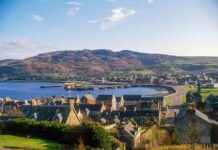Flamingo Land Decision Day: What to Expect and How to Watch Live
September 16 is set to be a crucial day for the Loch Lomond & The Trossachs National Park Authority board as they convene in the lochside village of Balloch to make a decision on the highly controversial Lomond Banks project. This decision comes after a lengthy process involving site visits, hearings, and meetings.
The proposed Lomond Banks project, often referred to as ‘Flamingo Land’ Loch Lomond due to its parent company being the Yorkshire theme park operator, encompasses a range of facilities including woodland lodges, hotels, a monorail, and a waterpark. Situated at the southernmost point of Loch Lomond, this development has been the subject of intense scrutiny and opposition over the past eight years, making it the most objected to planning application in Scottish history.
The decision on this second application for the development is eagerly anticipated and could bring closure to a prolonged saga. Despite a report recommending rejection of the application by the Loch Lomond & The Trossachs National Park Authority, the final decision will rest with the board members following a comprehensive review process.
It is expected that the meeting on September 16 may extend late into the day, possibly until 7 pm, given the level of interest and the number of individuals wishing to speak on the matter. The public will have the opportunity to attend the meeting in person at Lomond Parish Church in Balloch, with limited numbers due to venue capacity, or watch the proceedings live on the National Park Authority website.
Confirmed Speakers and Their Stances
The National Park Authority has received 13 applications to speak at the hearing for the Lomond Banks planning application, with 5 speakers supporting the proposal and 8 opposing it. Each speaker will have up to 5 minutes to present their views, followed by a possible question time.
Objecting to the development, Lynne Somerville from the Balloch & Haldane Community Council expressed concerns about the impact of the proposed project on the natural beauty of Loch Lomond. She highlighted breaches of various policies and the lack of community input in the decision-making process.
In support of the development, planner Steve Callan and community engagement lead Fiona Robertson from Lomond Banks emphasized that the project is not solely a theme park but includes holiday lodges, hotels, and amenities that would benefit the area. They addressed concerns raised by the community and outlined commitments to preserve access and environmental features.
Representing objections submitted via the Scottish Green Party’s portal, Ross Greer MSP underscored the scale of the development as a key issue, expressing concerns about increased traffic, environmental disruption, and the exclusionary nature of the project. He emphasized the need for a more sustainable and community-focused approach.
Parish minister Rev Ian H Miller voiced support for the development, citing potential benefits such as inward investment, job creation, and enhanced tourism opportunities for Balloch and the surrounding areas. He emphasized the importance of making Balloch a more attractive tourist destination while respecting the local community and environment.
Objecting to the application, Jackie Baillie MSP acknowledged some improvements but maintained her opposition, citing the need for a more fitting development for the gateway to Loch Lomond. She highlighted concerns about the project’s impact on the local area and emphasized the importance of ensuring the right development for the region.
Supporting the development, Anne Urquhart from the Loch Lomond Steamship Company outlined the potential economic benefits and enhanced visitor experiences that Lomond Banks could bring to Balloch. She emphasized the importance of revitalizing the area and providing sustainable transport options for visitors.
In favor of the project, James Fraser from Friends of Loch Lomond and The Trossachs highlighted the need for regeneration and economic growth in Balloch, emphasizing the potential for job creation and improved tourism offerings. He stressed the importance of sustainable development to support local businesses and enhance the area’s appeal.
Objecting to the application, Cllr Jonathan McColl raised concerns about the development’s impact on the natural and cultural heritage of the area, as well as the potential economic risks to local businesses. He emphasized the need for a more balanced and sustainable approach to development in the region.
Representing Ross Greer MSP, Ian Cowan submitted objections based on policy breaches and health risks posed by the development, particularly in relation to heavy metal contamination and flood risk. He highlighted the need for a thorough assessment of the project’s environmental impact and compliance with regulations.
Additional speakers include Christine Aitchison, Stewart Gibb from Helensburgh and District Access Trust, Simon Ritchie from Woodland Trust Scotland, and Jack Fordy from Bonhill & Dalmonach Community Council, each presenting their perspectives on the Lomond Banks project.
National Park Authority Report and Recommendations
The National Park Authority report recommending rejection of the Lomond Banks planning application cited concerns about the project’s location in a flood risk area without adequate policy support. The report highlighted the lack of biodiversity enhancements, tree removal, and conflicts with key planning policies and frameworks.
Addressing the conflict between the conservation of natural and cultural heritage and promoting sustainable economic and social development, the report emphasized the need to prioritize conservation objectives. It outlined the discrepancies between the proposed development and the National Park’s aims, calling for a more balanced and environmentally conscious approach to the project.
The decision on the Lomond Banks application is poised to be a landmark moment for the Loch Lomond & The Trossachs National Park Authority, with significant implications for the future of the region. As stakeholders on both sides of the debate prepare to make their voices heard, the outcome of the decision will shape the landscape of Loch Lomond and the surrounding areas for years to come.
































